Spectra of W VIII and W IX in the EUV Region
Abstract
:1. Introduction
2. Experimental Techniques
3. Results and Discussion
3.1. W VIII and Isoelectronic Ion Spectra
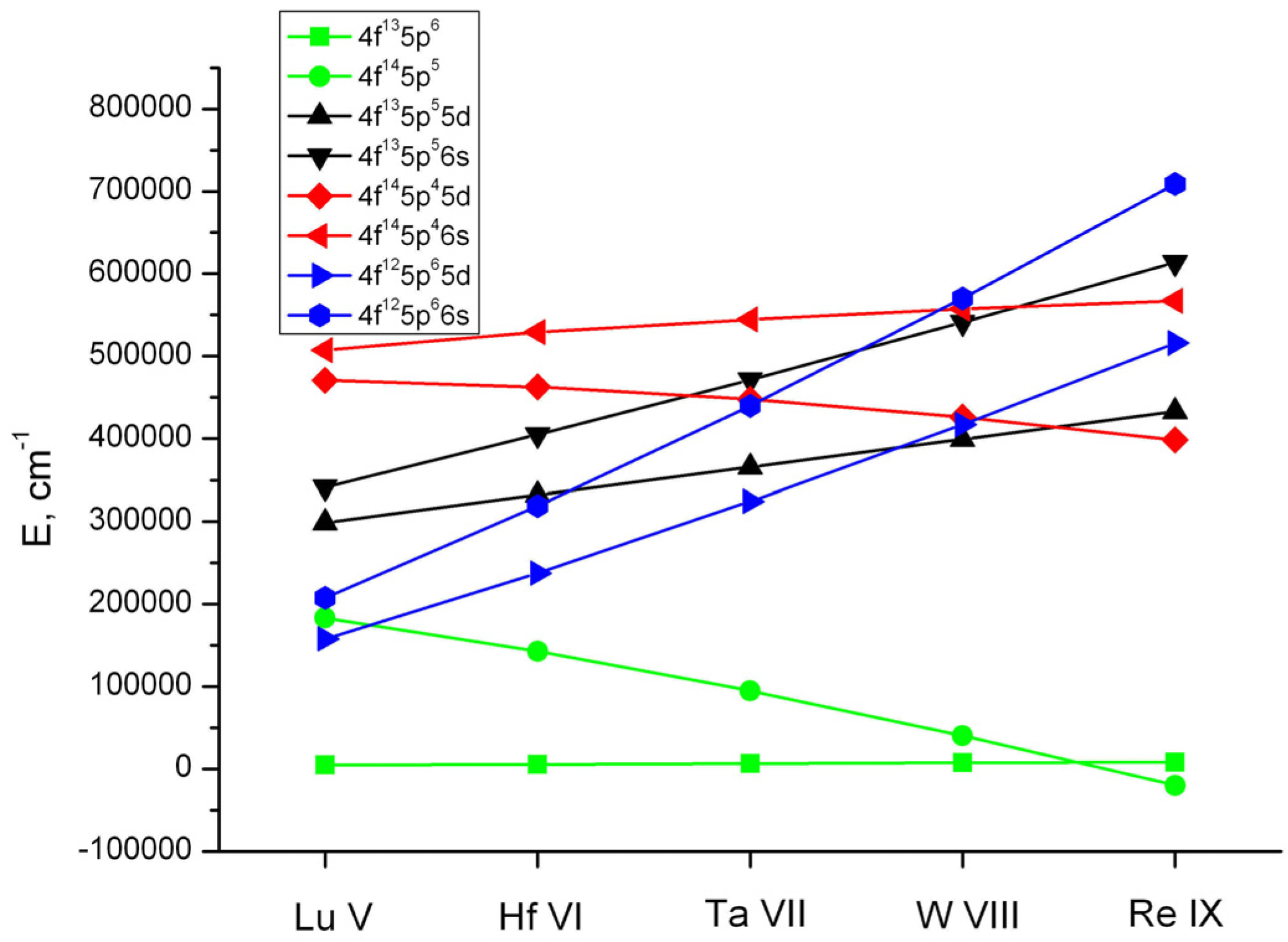

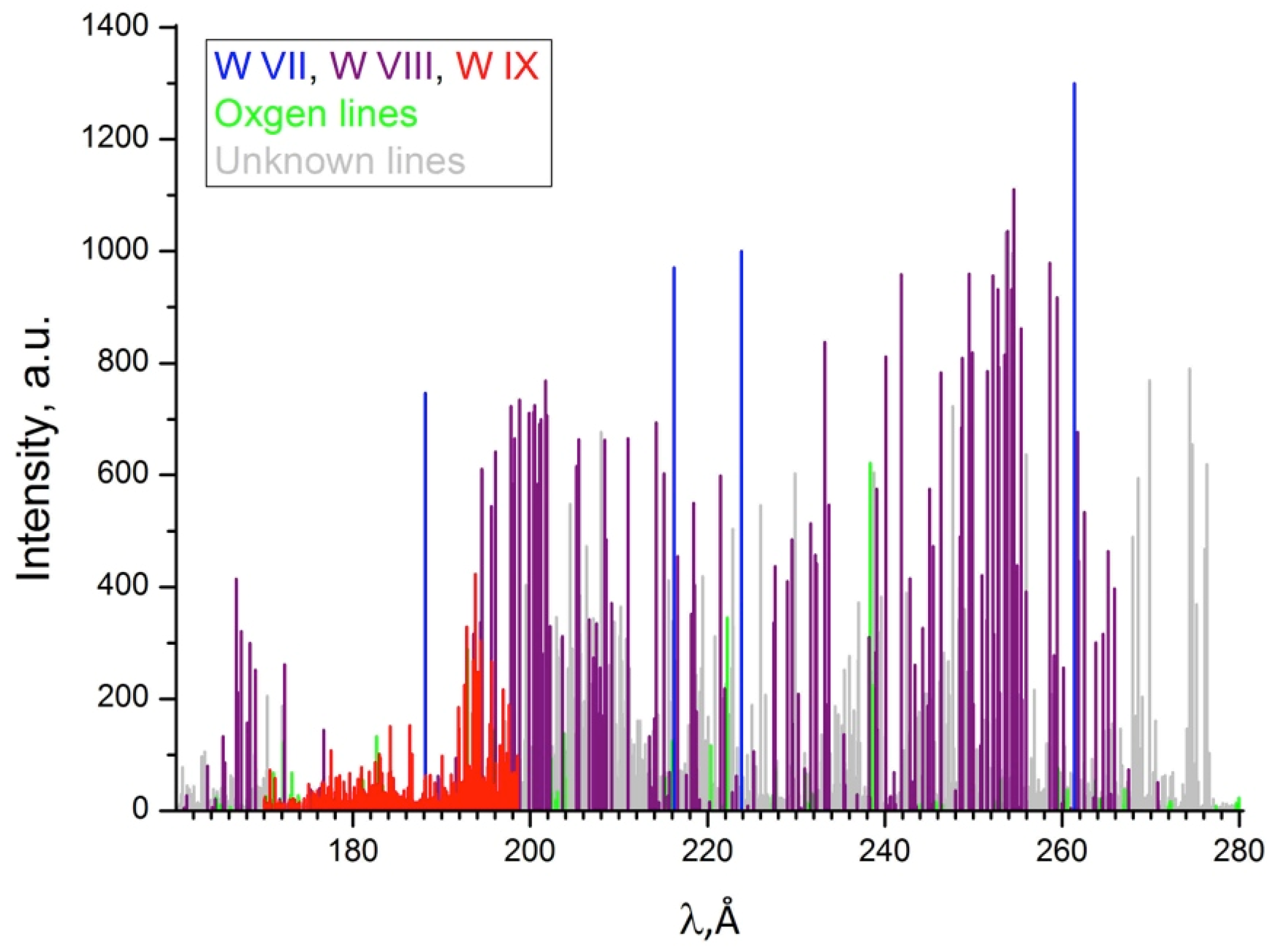
| λ (Å)h | o-ca (Å) | σ (cm−1) | Int. | gA (108·s−1) | Lower Level | Upper Level | ||||
|---|---|---|---|---|---|---|---|---|---|---|
| Config.b | Term | E (cm−1) | Config.c | J | E(cm−1) | |||||
| 160.940 | −0.002 | 621351 | 5 | 10 | 4f135p6 | 2F7/2 | 0 | 4f135p56s | 5/2 | 621343 |
| 161.057 | −0.002 | 620897 | 4 | 10 | 4f145p5 | 2P3/2 | 1233 | 4f135p56s | 3/2 | 622123 |
| 161.260 | −0.002 | 620118 | 27 | 147 | 4f145p5 | 2P3/2 | 1233 | 4f135p56s | 5/2 | 621343 |
| 163.596 | 0.006 | 611261 | 80 | 12 | 4f135p6 | 2F7/2 | 0 | 4f135p56s | 7/2 | 611283 |
| 164.143 | −0.005 | 609225 | 6 | 4 | 4f135p6 | 2F7/2 | 0 | 4f135p56s | 5/2 | 609206 |
| 164.479 | −0.002 | 607979 | 21 | 1 | 4f145p5 | 2P3/2 | 1233 | 4f135p56s | 5/2 | 609206 |
| 165.369 | 0.001 | 604708 | 130 | 1365 | 4f135p6 | 2F5/2 | 17410 | 4f135p56s | 3/2 | 622123 |
| 165.583 | 0.002 | 603927 | 86 | 900 | 4f135p6 | 2F5/2 | 17410 | 4f135p56s | 5/2 | 621343 |
| 166.827 | 0.000 | 599422 | 410 | 3397 | 4f135p6 | 2F7/2 | 0 | 4f135p56s | 9/2 | 599423 |
| 166.971 | −0.001 | 598905 | 210 | 1373 | 4f135p6 | 2F7/2 | 0 | 4f135p56s | 7/2 | 598904 |
| 167.382 | 597435 | 320 | 2172 | 4f135p6 | 2F7/2 | 0 | 4f135p56s | 5/2 | 597436 | |
| 168.084 | 594941 | 160 | 649 | 4f135p6 | 2F7/2 | 0 | 4f135p56s | 7/2 | 594941 | |
| 168.381 | −0.005 | 593891 | 300 | 2578 | 4f135p6 | 2F5/2 | 17410 | 4f135p56s | 7/2 | 611283 |
| 168.980 | 0.003 | 591787 | 250 | 584 | 4f135p6 | 2F5/2 | 17410 | 4f135p56s | 5/2 | 609206 |
| 171.727 | 0.002 | 582320 | 21 | 347 | 4f145p5 | 2P3/2 | 1233 | 4f145p46s | 3/2 | 583560 |
| 171.973 | 0.002 | 581488 | 8 | 46 | 4f135p6 | 2F5/2 | 17410 | 4f135p56s | 7/2 | 598904 |
| 172.295 | 0.001 | 580400 | 260 | 1431 | 4f145p5 | 2P3/2 | 1233 | 4f145p46s | 5/2 | 581635 |
| 175.199 | −0.003 | 570781 | 38 | 561 | 4f145p5 | 2P3/2 | 1233 | 4f145p46s | 1/2 | 572004 |
| 176.237 | −0.002 | 567418 | 40 | 299 | 4f145p5 | 2P3/2 | 1233 | 4f145p46s | 3/2 | 568644 |
| 176.630 | −0.002 | 566156 | 54 | 111 | 4f135p6 | 2F5/2 | 17410 | 4f145p46s | 3/2 | 583560 |
| 176.694 | 0.002 | 565951 | 150 | 405 | 4f145p5 | 2P3/2 | 1233 | 4f145p46s | 3/2 | 567191 |
| 177.232 | −0.002 | 564232 | 23 | 90 | 4f135p6 | 2F5/2 | 17410 | 4f145p46s | 5/2 | 581635 |
| 181.410 | −0.001 | 551237 | 17 | 202 | 4f135p6 | 2F5/2 | 17410 | 4f145p46s | 3/2 | 568644 |
| 181.888 | −0.003 | 549788 | 12 | 419 | 4f135p6 | 2F5/2 | 17410 | 4f145p46s | 3/2 | 567191 |
| 187.608 | −0.009 | 533027 | 12 | 56 | 4f145p5 | 2P1/2 | 89123 | 4f135p56s | 3/2 | 622123 |
| 189.616 | −0.002 | 527381 | 62 | 130 | 4f135p6 | 2F7/2 | 0 | 4f135p56s | 7/2 | 527376 |
| 189.667 | −0.004 | 527241 | 58 | 718 | 4f145p5 | 2P3/2 | 1233 | 4f145p45d | 1/2 | 528462 |
| 191.348e | 0.001 | 522607 | 11 | 1069 | 4f135p6 | 2F7/2 | 0 | 4f125p65d | 5/2 | 522610 |
| 191.617 | 0.001 | 521875 | 94 | 95 | 4f135p6 | 2F7/2 | 0 | 4f135p56s | 5/2 | 521876 |
| 192.070 | 0.000 | 520643 | 32 | 3 | 4f145p5 | 2P3/2 | 1233 | 4f135p56s | 5/2 | 521876 |
| 193.614 | 0.001 | 516492 | 320 | 102 | 4f135p6 | 2F7/2 | 0 | 4f135p55d | 5/2 | 516493 |
| 194.077 | 0.000 | 515259 | 61 | 77 | 4f145p5 | 2P3/2 | 1233 | 4f135p55d | 5/2 | 516493 |
| 194.315 | 0.000 | 514628 | 52 | 59 | 4f135p6 | 2F7/2 | 0 | 4f135p56s | 5/2 | 514628 |
| 194.397 | 0.001 | 514411 | 340 | 249 | 4f135p6 | 2F7/2 | 0 | 4f135p56s | 7/2 | 514413 |
| 194.527 | −0.002 | 514068 | 610 | 2278 | 4f135p6 | 2F7/2 | 0 | 4f135p56s | 5/2 | 514063 |
| 194.998 | 0.002 | 512825 | 47 | 57 | 4f145p5 | 2P3/2 | 1233 | 4f135p56s | 5/2 | 514063 |
| 195.021 | 0.009 | 512765 | 16 | 251 | 4f135p6 | 2F7/2 | 0 | 4f135p55d | 7/2 | 512790 |
| 195.598 | −0.004 | 511252 | 540 | 2166 | 4f135p6 | 2F5/2 | 17410 | 4f135p56s | 3/2 | 528652 |
| 196.093 | 0.002 | 509961 | 640 | 2868 | 4f135p6 | 2F5/2 | 17410 | 4f135p56s | 7/2 | 527376 |
| 197.835 | 0.000 | 505472 | 720 | 8923 | 4f135p6 | 2F5/2 | 17410 | 4f125p65d | 3/2 | 522881 |
| 197.941e | 0.000 | 505202 | 410 | 1569 | 4f135p6 | 2F5/2 | 17410 | 4f125p65d | 5/2 | 522610 |
| 198.171 | 504613 | 590 | 5013 | 4f135p6 | 2F7/2 | 0 | 4f135p56s | 9/2 | 504615 | |
| 198.229 | 0.000 | 504467 | 670 | 3950 | 4f135p6 | 2F5/2 | 17410 | 4f135p56s | 5/2 | 521876 |
| 198.625 | −0.001 | 503461 | 16 | 5 | 4f145p5 | 2P3/2 | 1233 | 4f125p65d | 3/2 | 504691 |
| 198.779 | 503070 | 740 | 5840 | 4f135p6 | 2F7/2 | 0 | 4f135p56s | 7/2 | 503071 | |
| 199.875 | 500312 | 710 | 1958 | 4f135p6 | 2F7/2 | 0 | 4f135p56s | 5/2 | 500313 | |
| 200.367 | 0.000 | 499085 | 710 | 18664 | 4f135p6 | 2F5/2 | 17410 | 4f135p55d | 5/2 | 516493 |
| 200.483 | −0.001 | 498796 | 730 | 30107 | 4f135p6 | 2F7/2 | 0 | 4f135p55d | 7/2 | 498792 |
| 200.787 | −0.001 | 498041 | 580 | 20835 | 4f135p6 | 2F7/2 | 0 | 4f135p55d | 5/2 | 498037 |
| 201.079 | −0.004 | 497317 | 690 | 2027 | 4f145p5 | 2P3/2 | 1233 | 4f145p45d | 3/2 | 498541 |
| 201.119 | 0.000 | 497217 | 440 | 3154 | 4f135p6 | 2F5/2 | 17410 | 4f135p56s | 5/2 | 514628 |
| 201.205 | −0.001 | 497006 | 700 | 1388 | 4f135p6 | 2F5/2 | 17410 | 4f135p56s | 7/2 | 514413 |
| 201.288 | 0.001 | 496800 | 280 | 2238 | 4f145p5 | 2P3/2 | 1233 | 4f135p55d | 5/2 | 498037 |
| 201.739 | 495691 | 770 | 38110 | 4f135p6 | 2F7/2 | 0 | 4f135p55d | 9/2 | 495690 | |
| 201.864 | −0.001 | 495382 | 710 | 30320 | 4f135p6 | 2F5/2 | 17410 | 4f135p55d | 7/2 | 512790 |
| 202.250 | 0.000 | 494437 | 330 | 1336 | 4f145p5 | 2P1/2 | 89123 | 4f145p46s | 3/2 | 583560 |
| 203.623 | 0.000 | 491104 | 310 | 8110 | 4f145p5 | 2P3/2 | 1233 | 4f145p45d | 1/2 | 492337 |
| 205.221 | 0.001 | 487280 | 620 | 6384 | 4f135p6 | 2F5/2 | 17410 | 4f125p65d | 3/2 | 504691 |
| 205.479 | 486668 | 660 | 3063 | 4f145p5 | 2P3/2 | 1233 | 4f145p46s | 3/2 | 487901 | |
| 206.634 | −0.002 | 483947 | 340 | 1646 | 4f145p5 | 2P3/2 | 1233 | 4f135p55d | 5/2 | 485175 |
| 207.092 | 0.002 | 482878 | 270 | 746 | 4f145p5 | 2P1/2 | 89123 | 4f145p46s | 1/2 | 572004 |
| 207.466 | 0.001 | 482007 | 340 | 2816 | 4f145p5 | 2P3/2 | 1233 | 4f135p55d | 3/2 | 483243 |
| 207.690 | −0.006 | 481488 | 43 | 137 | 4f135p6 | 2F7/2 | 0 | 4f145p46s | 5/2 | 481473 |
| 207.736 | 0.001 | 481381 | 170 | 252 | 4f135p6 | 2F5/2 | 17410 | 4f135p55d | 7/2 | 498792 |
| 207.850 | 0.007 | 481116 | 51 | 54 | 4f135p6 | 2F5/2 | 17410 | 4f145p45d | 3/2 | 498541 |
| 207.884 | −0.001 | 481038 | 260 | 813 | 4f135p6 | 2F7/2 | 0 | 4f145p45d | 5/2 | 481035 |
| 208.227 | −0.002 | 480245 | 170 | 176 | 4f145p5 | 2P3/2 | 1233 | 4f145p46s | 5/2 | 481473 |
| 208.420 | 0.001 | 479800 | 660 | 14526 | 4f145p5 | 2P3/2 | 1233 | 4f145p45d | 5/2 | 481035 |
| 208.543 | 0.002 | 479517 | 490 | 5119 | 4f145p5 | 2P1/2 | 89123 | 4f145p46s | 3/2 | 568644 |
| 209.175 | 0.000 | 478070 | 370 | 6942 | 4f145p5 | 2P1/2 | 89123 | 4f145p46s | 3/2 | 567191 |
| 211.027 | 0.005 | 473873 | 670 | 4427 | 4f145p5 | 2P3/2 | 1233 | 4f145p45d | 3/2 | 475117 |
| 213.436 | −0.001 | 468524 | 130 | 3 | 4f135p6 | 2F7/2 | 0 | 4f125p65d | 5/2 | 468523 |
| 213.661 | 0.001 | 468030 | 42 | 2 | 4f135p6 | 2F7/2 | 0 | 4f125p65d | 5/2 | 468034 |
| 213.785 | 0.003 | 467759 | 27 | 130 | 4f135p6 | 2F5/2 | 17410 | 4f135p55d | 5/2 | 485175 |
| 214.001 | 0.001 | 467287 | 170 | 140 | 4f145p5 | 2P3/2 | 1233 | 4f125p65d | 5/2 | 468523 |
| 214.229 | 0.005 | 466791 | 690 | 2080 | 4f145p5 | 2P3/2 | 1233 | 4f125p65d | 5/2 | 468034 |
| 214.488 | −0.003 | 466226 | 15 | 7 | 4f135p6 | 2F7/2 | 0 | 4f125p65d | 5/2 | 466219 |
| 215.055 | −0.005 | 464996 | 600 | 946 | 4f145p5 | 2P3/2 | 1233 | 4f125p65d | 5/2 | 466219 |
| 215.496 | 0.008 | 464046 | 26 | 7 | 4f135p6 | 2F5/2 | 17410 | 4f145p46s | 5/2 | 481473 |
| 215.692 | 0.001 | 463624 | 69 | 83 | 4f135p6 | 2F5/2 | 17410 | 4f145p45d | 5/2 | 481035 |
| 216.596 | 0.002 | 461689 | 460 | 369 | 4f145p5 | 2P3/2 | 1233 | 4f125p65d | 3/2 | 462927 |
| 217.601 | 0.006 | 459556 | 64 | 16 | 4f135p6 | 2F7/2 | 0 | 4f125p65d | 5/2 | 459570 |
| 218.174 | −0.006 | 458350 | 350 | 28 | 4f145p5 | 2P3/2 | 1233 | 4f125p65d | 5/2 | 459570 |
| 218.429 | 457814 | 550 | 215 | 4f135p6 | 2F7/2 | 0 | 4f125p65d | 9/2 | 457815 | |
| 218.477 | −0.003 | 457714 | 33 | 17 | 4f135p6 | 2F5/2 | 17410 | 4f145p45d | 3/2 | 475117 |
| 218.507 | 0.000 | 457651 | 400 | 118 | 4f135p6 | 2F7/2 | 0 | 4f135p55d | 5/2 | 457652 |
| 218.747 | −0.001 | 457148 | 180 | 238 | 4f145p5 | 2P3/2 | 1233 | 4f125p65d | 3/2 | 458380 |
| 219.097 | 0.000 | 456419 | 20 | 1 | 4f145p5 | 2P3/2 | 1233 | 4f135p55d | 5/2 | 457652 |
| 220.239 | 0.007 | 454053 | 16 | 2 | 4f135p6 | 2F7/2 | 0 | 4f125p65d | 7/2 | 454067 |
| 221.443 | 0.002 | 451583 | 600 | 483 | 4f145p5 | 2P3/2 | 1233 | 4f125p65d | 3/2 | 452821 |
| 221.908 | −0.006 | 450637 | 220 | 260 | 4f135p6 | 2F5/2 | 17410 | 4f125p65d | 5/2 | 468034 |
| 222.818 | 0.006 | 448797 | 33 | 65 | 4f135p6 | 2F5/2 | 17410 | 4f125p65d | 5/2 | 466219 |
| 223.260 | 0.000 | 447908 | 62 | 67 | 4f135p6 | 2F7/2 | 0 | 4f125p65d | 5/2 | 447909 |
| 224.573 | −0.002 | 445289 | 9 | 6 | 4f135p6 | 2F7/2 | 0 | 4f125p65d | 5/2 | 445286 |
| 225.203 | 0.005 | 444044 | 110 | 39 | 4f145p5 | 2P3/2 | 1233 | 4f125p65d | 5/2 | 445286 |
| 227.497 | −0.003 | 439566 | 340 | 200 | 4f135p6 | 2F7/2 | 0 | 4f125p65d | 7/2 | 439561 |
| 227.519 | 0.003 | 439523 | 56 | 13 | 4f145p5 | 2P1/2 | 89123 | 4f135p56s | 3/2 | 528652 |
| 227.617 | 0.003 | 439335 | 440 | 5786 | 4f145p5 | 2P1/2 | 89123 | 4f145p45d | 1/2 | 528462 |
| 229.011 | −0.002 | 436661 | 410 | 186 | 4f135p6 | 2F5/2 | 17410 | 4f125p65d | 7/2 | 454067 |
| 229.541 | 0.003 | 435652 | 490 | 15 | 4f135p6 | 2F7/2 | 0 | 4f145p45d | 7/2 | 435658 |
| 229.590 | 0.001 | 435558 | 160 | 125 | 4f135p6 | 2F7/2 | 0 | 4f125p65d | 5/2 | 435561 |
| 229.666 | −0.002 | 435415 | 58 | 29 | 4f135p6 | 2F5/2 | 17410 | 4f125p65d | 3/2 | 452821 |
| 230.246 | 0.005 | 434318 | 210 | 156 | 4f145p5 | 2P3/2 | 1233 | 4f125p65d | 5/2 | 435561 |
| 230.544 | 0.001 | 433757 | 5 | 603 | 4f145p5 | 2P1/2 | 89123 | 4f125p65d | 3/2 | 522881 |
| 230.964 | −0.003 | 432967 | 75 | 57 | 4f135p6 | 2F7/2 | 0 | 4f125p65d | 5/2 | 432963 |
| 231.629 | 0.003 | 431725 | 510 | 319 | 4f145p5 | 2P3/2 | 1233 | 4f125p65d | 5/2 | 432963 |
| 232.176 | 430708 | 460 | 109 | 4f135p6 | 2F7/2 | 0 | 4f125p65d | 7/2 | 430708 | |
| 232.288 | 0.000 | 430499 | 440 | 195 | 4f135p6 | 2F5/2 | 17410 | 4f125p65d | 5/2 | 447909 |
| 233.225 | 0.004 | 428771 | 840 | 425 | 4f135p6 | 2F7/2 | 0 | 4f125p65d | 7/2 | 428777 |
| 233.525 | −0.002 | 428221 | 190 | 196 | 4f135p6 | 2F7/2 | 0 | 4f125p65d | 7/2 | 428216 |
| 233.709 | −0.003 | 427883 | 550 | 328 | 4f135p6 | 2F5/2 | 17410 | 4f125p65d | 5/2 | 445286 |
| 235.418 | 0.003 | 424776 | 140 | 78 | 4f135p6 | 2F7/2 | 0 | 4f125p65d | 5/2 | 424781 |
| 235.509 | −0.001 | 424612 | 47 | 10 | 4f145p5 | 2P3/2 | 1233 | 4f125p65d | 3/2 | 425843 |
| 236.884 | 0.002 | 422148 | 29 | 117 | 4f135p6 | 2F5/2 | 17410 | 4f125p65d | 7/2 | 439561 |
| 238.243 | 419739 | 310 | 125 | 4f135p6 | 2F5/2 | 17410 | 4f125p65d | 5/2 | 437149 | |
| 238.330 | −0.001 | 419586 | 24 | 6 | 4f135p6 | 2F7/2 | 0 | 4f125p65d | 7/2 | 419585 |
| 239.004 | 418402 | 280 | 119 | 4f135p6 | 2F7/2 | 0 | 4f125p65d | 9/2 | 418403 | |
| 239.089 | −0.003 | 418255 | 580 | 2 | 4f135p6 | 2F5/2 | 17410 | 4f145p45d | 7/2 | 435658 |
| 239.142 | −0.006 | 418162 | 150 | 101 | 4f135p6 | 2F5/2 | 17410 | 4f125p65d | 5/2 | 435561 |
| 240.107 | 416480 | 810 | 499 | 4f135p6 | 2F7/2 | 0 | 4f125p65d | 9/2 | 416481 | |
| 240.468 | −0.002 | 415855 | 10 | 9 | 4f135p6 | 2F7/2 | 0 | 4f125p65d | 5/2 | 415852 |
| 240.634 | 0.000 | 415569 | 26 | 728 | 4f145p5 | 2P1/2 | 89123 | 4f125p65d | 3/2 | 504691 |
| 241.037 | 0.008 | 414874 | 69 | 89 | 4f135p6 | 2F7/2 | 0 | 4f125p65d | 7/2 | 414888 |
| 241.183 | −0.002 | 414623 | 12 | 7 | 4f145p5 | 2P3/2 | 1233 | 4f125p65d | 5/2 | 415852 |
| 241.867 | 413451 | 960 | 716 | 4f135p6 | 2F7/2 | 0 | 4f125p65d | 9/2 | 413450 | |
| 242.819 | 0.002 | 411829 | 420 | 72 | 4f135p6 | 2F7/2 | 0 | 4f125p65d | 7/2 | 411832 |
| 242.829 | 0.004 | 411813 | 270 | 17 | 4f135p6 | 2F7/2 | 0 | 4f125p65d | 5/2 | 411819 |
| 243.088 | −0.004 | 411374 | 52 | 26 | 4f135p6 | 2F5/2 | 17410 | 4f125p65d | 7/2 | 428777 |
| 243.426 | 0.002 | 410802 | 120 | 21 | 4f135p6 | 2F5/2 | 17410 | 4f125p65d | 7/2 | 428216 |
| 243.434 | 410788 | 260 | 36 | 4f135p6 | 2F5/2 | 17410 | 4f125p65d | 3/2 | 428199 | |
| 243.518 | 0.004 | 410647 | 10 | 10 | 4f135p6 | 2F7/2 | 0 | 4f125p65d | 7/2 | 410654 |
| 243.551 | −0.003 | 410591 | 7 | 17 | 4f145p5 | 2P3/2 | 1233 | 4f125p65d | 5/2 | 411819 |
| 244.281 | −0.002 | 409364 | 330 | 74 | 4f135p6 | 2F7/2 | 0 | 4f125p65d | 5/2 | 409362 |
| 244.833 | 0.001 | 408442 | 190 | 52 | 4f145p5 | 2P3/2 | 1233 | 4f125p65d | 5/2 | 409676 |
| 244.839 | 0.001 | 408431 | 150 | 102 | 4f135p6 | 2F5/2 | 17410 | 4f125p65d | 3/2 | 425843 |
| 245.046 | 0.000 | 408087 | 580 | 191 | 4f135p6 | 2F7/2 | 0 | 4f125p65d | 7/2 | 408086 |
| 245.334 | −0.005 | 407607 | 12 | 14 | 4f145p5 | 2P3/2 | 1233 | 4f125p65d | 3/2 | 408833 |
| 245.474 | −0.002 | 407375 | 470 | 74 | 4f135p6 | 2F5/2 | 17410 | 4f125p65d | 5/2 | 424781 |
| 246.362 | 405907 | 780 | 291 | 4f135p6 | 2F7/2 | 0 | 4f125p65d | 9/2 | 405907 | |
| 248.007 | 0.000 | 403215 | 36 | 104 | 4f145p5 | 2P1/2 | 89123 | 4f145p45d | 1/2 | 492337 |
| 248.508 | 402401 | 490 | 262 | 4f135p6 | 2F5/2 | 17410 | 4f125p65d | 5/2 | 419811 | |
| 248.649 | 0.001 | 402174 | 690 | 329 | 4f135p6 | 2F5/2 | 17410 | 4f125p65d | 7/2 | 419585 |
| 248.765 | −0.001 | 401985 | 810 | 676 | 4f135p6 | 2F7/2 | 0 | 4f145p45d | 5/2 | 401984 |
| 249.533 | 0.001 | 400748 | 960 | 1369 | 4f145p5 | 2P3/2 | 1233 | 4f145p45d | 5/2 | 401984 |
| 249.873 | 400203 | 820 | 340 | 4f135p6 | 2F7/2 | 0 | 4f125p65d | 9/2 | 400203 | |
| 250.010 | 399984 | 190 | 104 | 4f135p6 | 2F5/2 | 17410 | 4f125p65d | 3/2 | 417394 | |
| 250.811 | 398706 | 120 | 106 | 4f135p6 | 2F7/2 | 0 | 4f135p55d | 9/2 | 398707 | |
| 250.978 | 0.001 | 398441 | 420 | 126 | 4f135p6 | 2F5/2 | 17410 | 4f125p65d | 5/2 | 415852 |
| 251.500 | −0.001 | 397614 | 340 | 87 | 4f135p6 | 2F7/2 | 0 | 4f125p65d | 5/2 | 397612 |
| 251.584 | −0.002 | 397481 | 790 | 528 | 4f135p6 | 2F5/2 | 17410 | 4f125p65d | 7/2 | 414888 |
| 252.203 | −0.001 | 396506 | 960 | 591 | 4f135p6 | 2F7/2 | 0 | 4f135p55d | 7/2 | 396505 |
| 252.285 | 0.001 | 396377 | 320 | 109 | 4f145p5 | 2P3/2 | 1233 | 4f125p65d | 5/2 | 397612 |
| 252.740 | −0.002 | 395664 | 930 | 1471 | 4f145p5 | 2P3/2 | 1233 | 4f135p55d | 3/2 | 396894 |
| 252.862 | −0.001 | 395473 | 790 | 2 | 4f135p6 | 2F7/2 | 0 | 4f135p55d | 7/2 | 395471 |
| 252.989 | 0.001 | 395274 | 210 | 48 | 4f135p6 | 2F7/2 | 0 | 4f135p55d | 5/2 | 395276 |
| 253.534 | −0.001 | 394424 | 590 | 187 | 4f135p6 | 2F5/2 | 17410 | 4f125p65d | 7/2 | 411832 |
| 253.541 | −0.003 | 394413 | 820 | 1411 | 4f135p6 | 2F5/2 | 17410 | 4f125p65d | 5/2 | 411819 |
| 253.653 | 0.001 | 394239 | 710 | 443 | 4f145p5 | 2P3/2 | 1233 | 4f145p45d | 1/2 | 395474 |
| 253.726 | −0.004 | 394126 | 23 | 14 | 4f145p5 | 2P1/2 | 89123 | 4f135p55d | 3/2 | 483243 |
| 253.779 | −0.001 | 394043 | 71 | 7 | 4f145p5 | 2P3/2 | 1233 | 4f135p55d | 5/2 | 395276 |
| 253.812 | 393992 | 1000 | 1960 | 4f135p6 | 2F7/2 | 0 | 4f125p65d | 7/2 | 393992 | |
| 254.294 | −0.001 | 393245 | 930 | 1535 | 4f135p6 | 2F5/2 | 17410 | 4f125p65d | 7/2 | 410654 |
| 254.551 | 392849 | 1000 | 1392 | 4f135p6 | 2F5/2 | 17410 | 4f125p65d | 3/2 | 410258 | |
| 254.928 | −0.001 | 392267 | 440 | 168 | 4f135p6 | 2F5/2 | 17410 | 4f125p65d | 5/2 | 409676 |
| 255.140 | 0.007 | 391942 | 6 | 34 | 4f135p6 | 2F5/2 | 17410 | 4f125p65d | 5/2 | 409362 |
| 255.401 | 391541 | 860 | 2981 | 4f135p6 | 2F7/2 | 0 | 4f135p55d | 9/2 | 391541 | |
| 255.479 | 0.001 | 391422 | 200 | 110 | 4f135p6 | 2F5/2 | 17410 | 4f125p65d | 3/2 | 408833 |
| 255.967 | 0.001 | 390675 | 390 | 510 | 4f135p6 | 2F5/2 | 17410 | 4f125p65d | 7/2 | 408086 |
| 258.592 | −0.004 | 386710 | 980 | 1433 | 4f135p6 | 2F7/2 | 0 | 4f135p55d | 5/2 | 386704 |
| 259.069 | −0.002 | 385998 | 280 | 154 | 4f145p5 | 2P1/2 | 89123 | 4f145p45d | 3/2 | 475117 |
| 259.419 | −0.004 | 385476 | 920 | 633 | 4f145p5 | 2P3/2 | 1233 | 4f135p55d | 5/2 | 386704 |
| 260.027 | −0.001 | 384576 | 14 | 31 | 4f135p6 | 2F5/2 | 17410 | 4f145p45d | 5/2 | 401984 |
| 260.146 | 384400 | 290 | 54 | 4f135p6 | 2F7/2 | 0 | 4f135p55d | 9/2 | 384400 | |
| 261.002 | −0.004 | 383139 | 5 | 49 | 4f135p6 | 2F7/2 | 0 | 4f135p55d | 5/2 | 383133 |
| 261.767 | 382019 | 680 | 155 | 4f135p6 | 2F7/2 | 0 | 4f135p55d | 7/2 | 382019 | |
| 261.849 | 0.000 | 381899 | 450 | 15 | 4f145p5 | 2P3/2 | 1233 | 4f135p55d | 5/2 | 383133 |
| 262.537 | 380899 | 530 | 53 | 4f135p6 | 2F7/2 | 0 | 4f135p55d | 9/2 | 380899 | |
| 263.521 | 0.006 | 379476 | 23 | 1 | 4f135p6 | 2F5/2 | 17410 | 4f135p55d | 3/2 | 396894 |
| 263.787 | 0.001 | 379094 | 300 | 73 | 4f135p6 | 2F5/2 | 17410 | 4f135p55d | 7/2 | 396505 |
| 264.508 | 0.001 | 378060 | 23 | 85 | 4f135p6 | 2F5/2 | 17410 | 4f135p55d | 7/2 | 395471 |
| 264.644d | 0.001 | 377867 | 320 | 111 | 4f135p6 | 2F7/2 | 0 | 4f135p55d | 5/2 | 377867 |
| 264.644d | 0.000 | 377867 | 320 | 72 | 4f135p6 | 2F5/2 | 17410 | 4f135p55d | 5/2 | 395276 |
| 265.168 | 377120 | 460 | 133 | 4f135p6 | 2F7/2 | 0 | 4f135p55d | 9/2 | 377119 | |
| 265.510 | 0.000 | 376633 | 30 | 78 | 4f145p5 | 2P3/2 | 1233 | 4f135p55d | 5/2 | 377867 |
| 265.919 | 0.000 | 376054 | 400 | 11 | 4f145p5 | 2P3/2 | 1233 | 4f135p55d | 3/2 | 377288 |
| 267.518 | −0.002 | 373807 | 74 | 3 | 4f145p5 | 2P1/2 | 89123 | 4f125p65d | 3/2 | 462927 |
| 270.794 | 0.007 | 369284 | 51 | 2 | 4f135p6 | 2F5/2 | 17410 | 4f135p55d | 5/2 | 386704 |
| 270.816 | 0.002 | 369254 | 10 | 76 | 4f145p5 | 2P1/2 | 89123 | 4f125p65d | 3/2 | 458380 |
- E = 291733.0 (4f123P2, 6p1/2) J = 3/2,
- E = 291764.8 (4f123P2, 6p1/2) J = 5/2,
- E = 296226.7 (4f121G4, 6p3/2) J = 5/2,
- E = 160846.4 (4f123H4, 5d5/2) J = 3/2,
- E = 176831.6 (4f123F3, 5d5/2) J = 11/2,
- E = 177390.0 (4f123F3, 5d5/2) J = 5/2,
- E = 197304.0 (4f121I6, 5d3/2) J = 13/2.
| λexp (Å) | λRitz (Å) | σRitz (cm−1) | Intensity (arb.) | gA (106·s−1) | Eodd (cm−1) | Jodd | Eeven (cm−1) | Jeven |
|---|---|---|---|---|---|---|---|---|
| 563.723a,d | 563.708 | 177396.9 | 100 | 425 | 0.0 | 7/2 | 177396.9 | 9/2 |
| 563.723a,d | 563.730 | 177390.0 | 100 | 2108 | 0.0 | 7/2 | 177390.0 | 5/2 |
| 786.582 | 786.572 | 127134.0 | 1 | 67 | 287980.4 | 5/2 | 160846.4 | 3/2 |
| 806.043 | 806.046 | 124062.4 | 1 | 668 | 284908.8 | 5/2 | 160846.4 | 3/2 |
| 856.592 | 856.593 | 116741.5 | 6 | 1552 | 277587.9 | 5/2 | 160846.4 | 3/2 |
| 874.638 | 874.640 | 114332.7 | 6 | 2451 | 296226.7 | 5/2 | 181894.0 | 7/2 |
| 875.645 | 875.644 | 114201.7 | 6 | 3034 | 296226.7 | 5/2 | 182025.0 | 5/2 |
| 880.543b,d | 880.534 | 113567.5 | 20 | 3306 | 274413.9 | 5/2 | 160846.4 | 3/2 |
| 880.543b,d | 880.556 | 113564.6 | 20 | 4832 | 280099.9 | 7/2 | 166535.3 | 7/2 |
| 898.980 | 898.985 | 111236.6 | 40 | 15750 | 288068.2 | 9/2 | 176831.6 | 11/2 |
| 909.941 | 909.941 | 109897.2 | 1 | 797 | 287287.2 | 5/2 | 177390.0 | 5/2 |
| 910.156 | 910.160 | 109870.8 | 4 | 1693 | 291764.8 | 5/2 | 181894.0 | 7/2 |
| 911.242 | 911.246 | 109739.8 | 5 | 2090 | 291764.8 | 5/2 | 182025.0 | 5/2 |
| 911.509 | 911.511 | 109708.0 | 5 | 1915 | 291733.0 | 3/2 | 182025.0 | 5/2 |
| 914.012 | 914.012 | 109407.8 | 3 | 1327 | 296226.7 | 5/2 | 186818.9 | 5/2 |
| 914.326 | 914.326 | 109370.2 | 3 | 910 | 286201.8 | 9/2 | 176831.6 | 11/2 |
| 919.071 | 919.076 | 108804.9 | 3 | 654 | 286201.8 | 9/2 | 177396.9 | 9/2 |
| 920.269 | 920.265 | 108664.3 | 3 | 901 | 285495.9 | 11/2 | 176831.6 | 11/2 |
| 952.873 | 952.872 | 104945.9 | 1 | 1638 | 291764.8 | 5/2 | 186818.9 | 5/2 |
| 953.165 | 953.161 | 104914.1 | 1 | 1317 | 291733.0 | 3/2 | 186818.9 | 5/2 |
| 974.890d | 974.886 | 102576.1 | 1 | 1498 | 291764.8 | 5/2 | 189188.7 | 7/2 |
| 974.890d | 974.889 | 102575.8 | 1 | 5339 | 299879.8 | 11/2 | 197304.0 | 13/2 |
| 978.015 | 978.017 | 102247.7 | 4 | 9081 | 299551.7 | 13/2 | 197304.0 | 13/2 |
| Configuration | Parameter | FIT | Unc. | Status a | HFR | FIT/HFR b |
|---|---|---|---|---|---|---|
| Odd | ||||||
| 4f135s25p6 | Eav | 7461 | 0 | 7546 | −85 | |
| ζ(4f) | 4974 | 0 | 5030 | 0.989 | ||
| 4f145s25p5 | Eav | 30529 | 0 | 40520 | −9991 | |
| ζ(5p) | 58593 | 0 | 58976 | 0.994 | ||
| Even | ||||||
| 4f145s5p6 | Eav | 377512 | f | 384795 | −7283 | |
| 4f135s25p55d | Eav | 403014 | 241 | 399311 | 3703 | |
| ζ(4f) | 5020 | 42 | r11 | 5045 | 0.995 | |
| ζ(5p) | 60627 | 116 | r2 | 61713 | 0.982 | |
| ζ(5d) | 4668 | 109 | r10 | 4773 | 0.978 | |
| F2(4f,5p) | 52499 | 1446 | r12 | 67376 | 0.779 | |
| F2(4f,5d) | 33847 | 1845 | r4 | 45326 | 0.747 | |
| F4(4f,5d) | 16437 | 896 | r4 | 22012 | 0.747 | |
| F2(5p,5d) | 65257 | 2675 | r7 | 78482 | 0.831 | |
| G2(4f,5p) | 28419 | 1152 | r3 | 27466 | 1.035 | |
| G4(4f,5p) | 23650 | 959 | r3 | 22857 | 1.035 | |
| G1(4f,5d) | 14185 | 369 | r5 | 15975 | 0.888 | |
| G3(4f,5d) | 13292 | 346 | r5 | 14969 | 0.888 | |
| G5(4f,5d) | 10627 | 277 | r5 | 11968 | 0.888 | |
| G1(5p,5d) | 67784 | 615 | r1 | 95279 | 0.711 | |
| G3(5p,5d) | 42727 | 388 | r1 | 60060 | 0.711 | |
| 4f135s25p56d | Eav | 775400 | f | 772171 | 3229 | |
| 4f135s25p56s | Eav | 542202 | 127 | 541049 | 1153 | |
| ζ(4f) | 5031 | 42 | r11 | 5059 | 0.994 | |
| ζ(5p) | 61816 | 118 | r2 | 62925 | 0.982 | |
| F2(4f,5p) | 53015 | 1460 | r12 | 68041 | 0.779 | |
| G2(4f,5p) | 28612 | 1160 | r3 | 27671 | 1.034 | |
| G4(4f,5p) | 23881 | 968 | r3 | 23081 | 1.035 | |
| G3(4f,6s) | 6291 | 1804 | 5312 | 1.184 | ||
| G1(5p,6s) | 9567 | 686 | r13 | 10655 | 0.898 | |
| 4f135s25p57s | Eav | 813134 | f | 813134 | 0 | |
| 4f145s25p45d | Eav | 420075 | 415 | 426261 | −6186 | |
| F2(5p,5p) | 76605 | 2809 | r14 | 92368 | 0.829 | |
| ζ(5p) | 58700 | 112 | r2 | 59661 | 0.984 | |
| ζ(5d) | 4419 | 104 | r10 | 4520 | 0.978 | |
| F2(5p,5d) | 64116 | 2628 | r7 | 77107 | 0.832 | |
| G1(5p,5d) | 66465 | 603 | r1 | 93327 | 0.712 | |
| G3(5p,5d) | 41891 | 380 | r1 | 58821 | 0.712 | |
| 4f145s25p46d | Eav | 778313 | f | 786313 | −8000 | |
| 4f145s25p46s | Eav | 550168 | 240 | 557405 | −7237 | |
| F2(5p,5p) | 77497 | 2842 | r14 | 92990 | 0.833 | |
| ζ(5p) | 59855 | 114 | r2 | 60835 | 0.984 | |
| G1(5p,6s) | 9579 | 687 | r13 | 10669 | 0.898 | |
| 4f145s25p47s | Eav | 813793 | f | 825793 | −12000 | |
| 4f145s5p56p | Eav | 992590 | f | 992590 | 0 | |
| 4f145s5p55f | Eav | 1092223 | f | 1092223 | 0 | |
| 4f125s25p65d | Eav | 429242 | 123 | 417114 | 12128 | |
| F2(4f,4f) | 148220 | 2174 | 176787 | 0.838 | ||
| F4(4f,4f) | 106797 | 6059 | 112472 | 0.95 | ||
| F6(4f,4f) | 72685 | 3157 | 81373 | 0.893 | ||
| α(4f) | 22 | f | 0 | |||
| β(4f) | −1000 | f | 0 | |||
| γ(4f) | −70 | f | 0 | |||
| ζ(4f) | 5198 | 43 | r11 | 5227 | 0.994 | |
| ζ(5d) | 4926 | 115 | r10 | 5038 | 0.978 | |
| F2(4f,5d) | 36271 | 1297 | r6 | 46227 | 0.785 | |
| F4(4f,5d) | 17578 | 629 | r6 | 22404 | 0.785 | |
| G1(4f,5d) | 14023 | 365 | r5 | 15792 | 0.888 | |
| G3(4f,5d) | 13329 | 347 | r5 | 15011 | 0.888 | |
| G5(4f,5d) | 10710 | 279 | r5 | 12062 | 0.888 | |
| 4f125s25p66d | Eav | 819431 | f | 803431 | 16000 | |
| 4f125s25p66s | Eav | 579803 | f | 570086 | 9717 | |
| F2(4f,4f) | 147636 | f | 177235 | 0.833 | ||
| F4(4f,4f) | 110752 | f | 112783 | 0.982 | ||
| F6(4f,4f) | 78585 | f | 81606 | 0.963 | ||
| α(4f) | 22 | f | 0 | |||
| β(4f) | −1000 | f | 0 | |||
| γ(4f) | −70 | f | 0 | |||
| ζ(4f) | 5161 | f | 5241 | 0.985 | ||
| G3(4f,6s) | 3974 | f | 5245 | 0.758 | ||
| 4f135s25p55d–5s25p45d | D2(4f,5p,4f,4f) | −5660 | 99 | r8 | −6553 | 0.864 |
| D4(4f,5p,4f,4f) | −309 | 5 | r8 | −359 | 0.864 | |
| D2(5p,5p,4f,5p) | −34863 | 611 | r8 | −40359 | 0.864 | |
| D2(5p,5d,4f,5d) | −27245 | 478 | r8 | −31540 | 0.864 | |
| D4(5p,5d,4f,5d) | −17854 | 313 | r8 | −20669 | 0.864 | |
| E1(5p,5d,4f,5d) | −24106 | 423 | r8 | −27907 | 0.864 | |
| E3(5p,5d,4f,5d) | −18066 | 317 | r8 | −20915 | 0.864 | |
| 4f135s25p55d–4f125s25p65d | D2(4f,4f,4f,5p) | −3787 | 52 | r9 | −4586 | 0.826 |
| D4(4f,4f,4f,5p) | 857 | 12 | r9 | 1039 | 0.826 | |
| D2(4f,5p,5p,5p) | −32514 | 444 | r9 | −39373 | 0.826 | |
| D2(4f,5d,5p,5d) | −25571 | 349 | r9 | −30966 | 0.826 | |
| D4(4f,5d,5p,5d) | −16823 | 230 | r9 | −20372 | 0.826 | |
| E1(4f,5d,5p,5d) | −22364 | 305 | r9 | −27081 | 0.826 | |
| E3(4f,5d,5p,5d) | −16960 | 231 | r9 | −20538 | 0.826 | |
| 4f145s25p45d–4f125s25p65d | D2(4f,4f,5p,5p) | 24561 | 335 | r9 | 29743 | 0.826 |
| D4(4f,4f,5p,5p) | 20265 | 277 | r9 | 24540 | 0.826 | |
| 4f135s25p56s–4f145s25p46s | D2(4f,5p,4f,4f) | −6391 | f | 1.0 | ||
| D4(4f,5p,4f,4f) | −244 | f | 1.0 | |||
| D2(5p,5p,4f,5p) | −40487 | f | 1.0 |
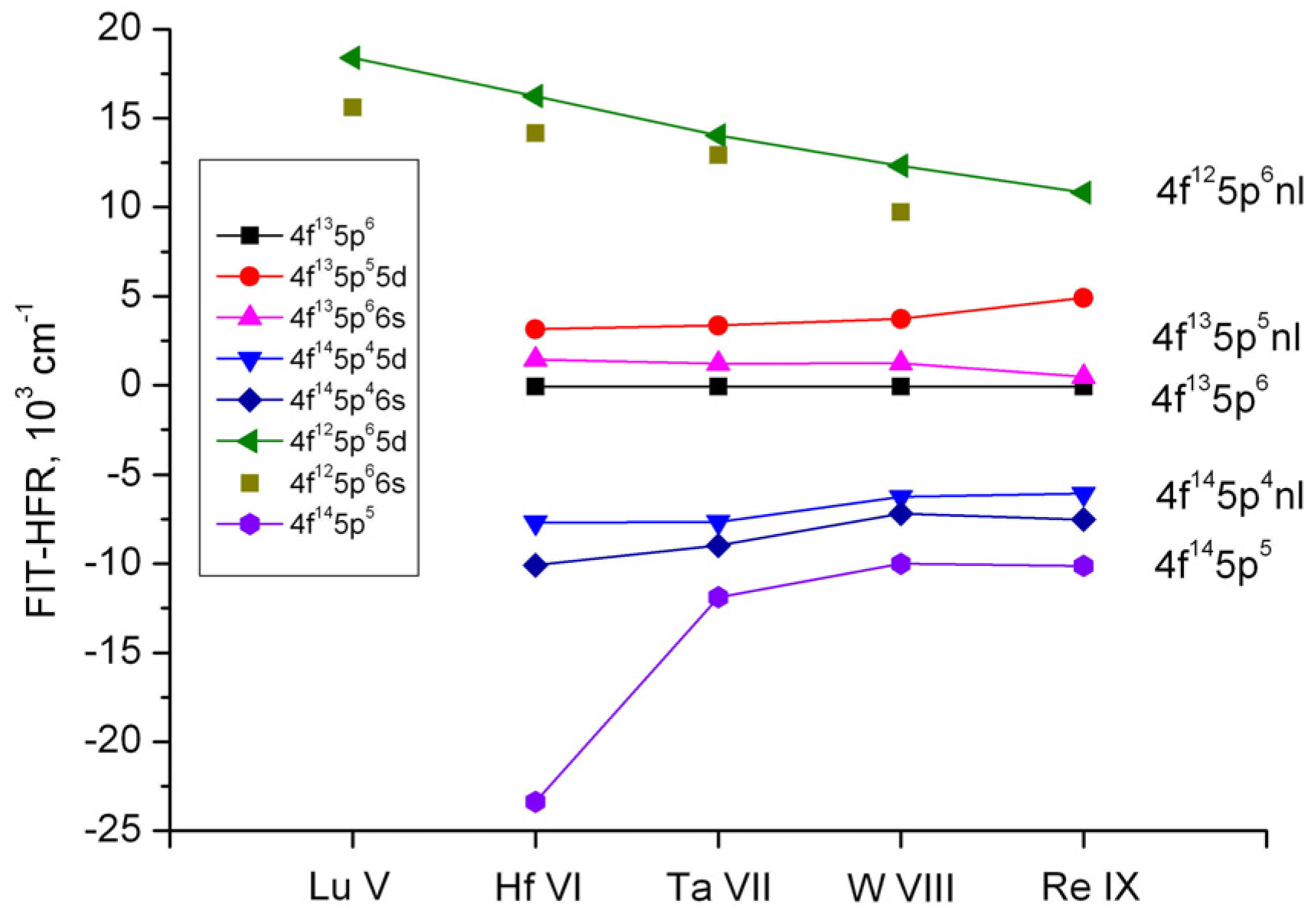
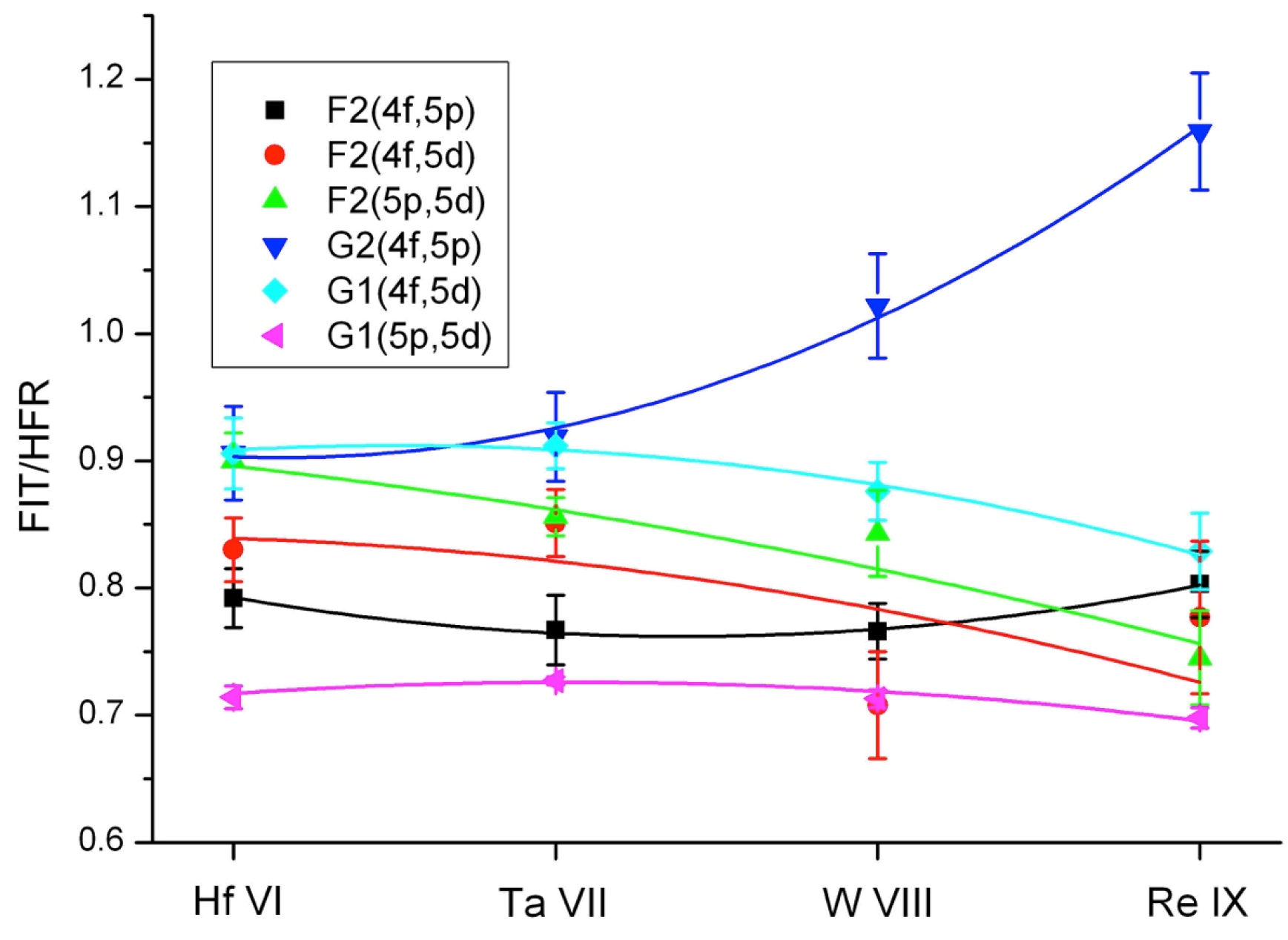
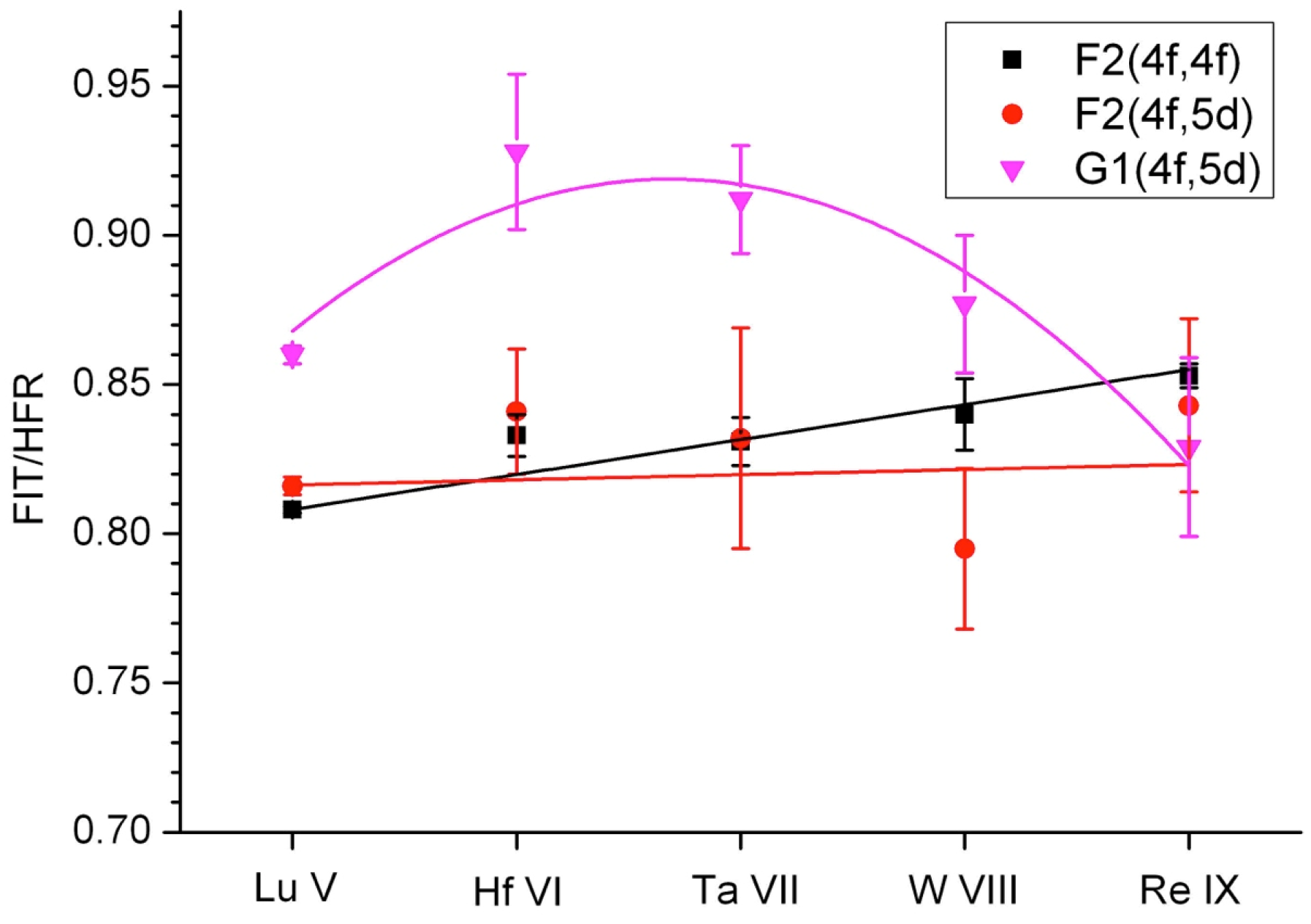
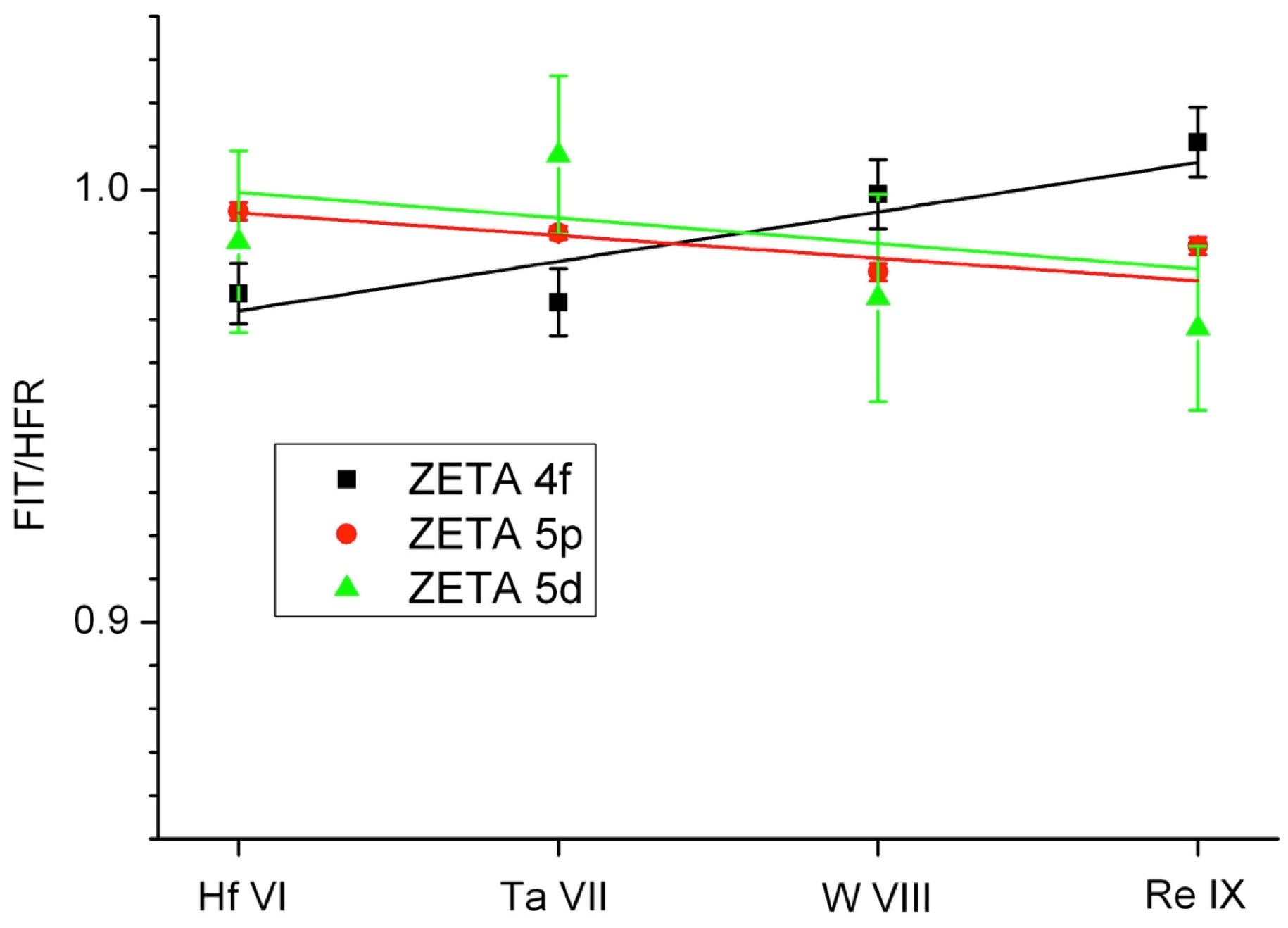
3.2. Spectrum of the W8+ Ion (W IX)
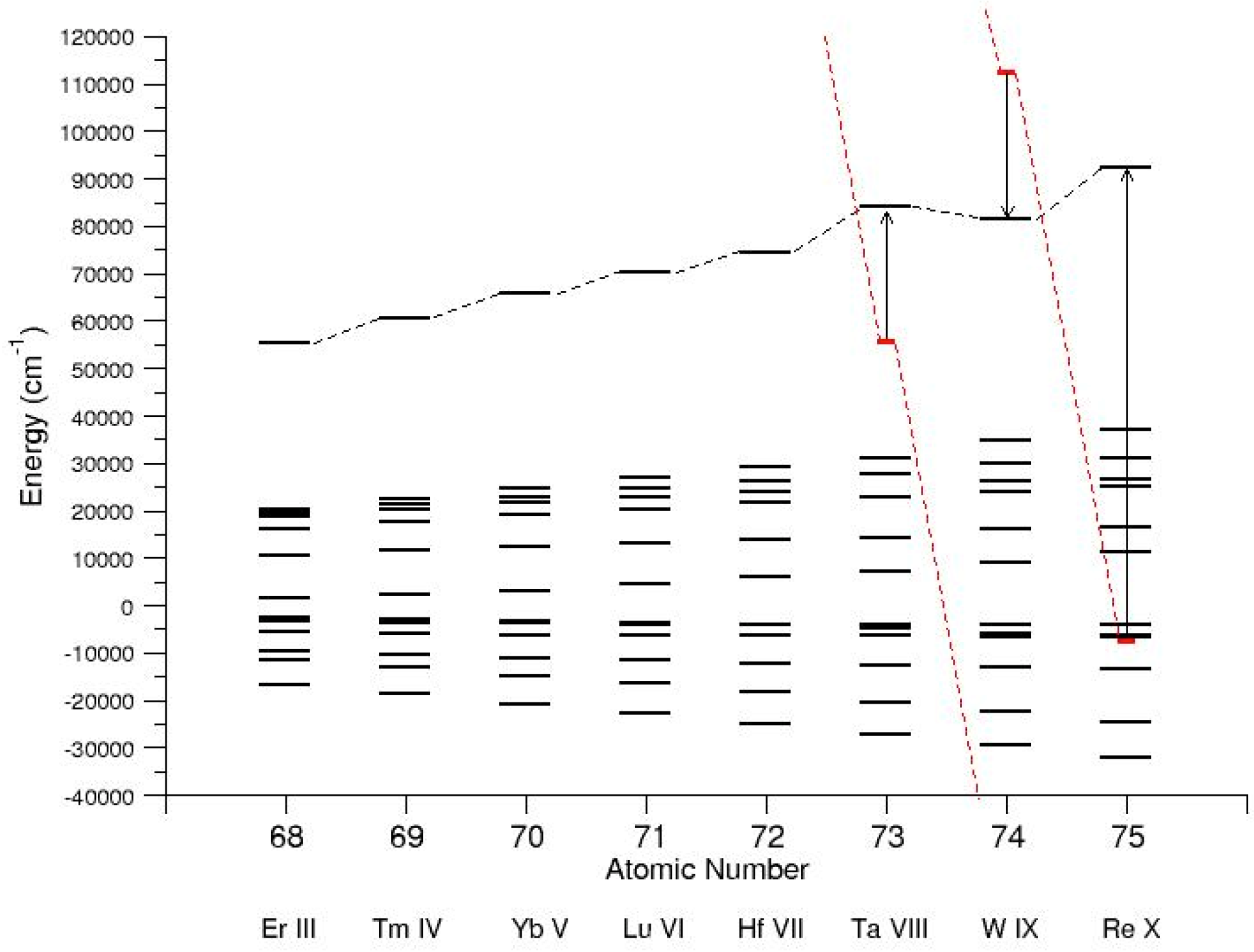
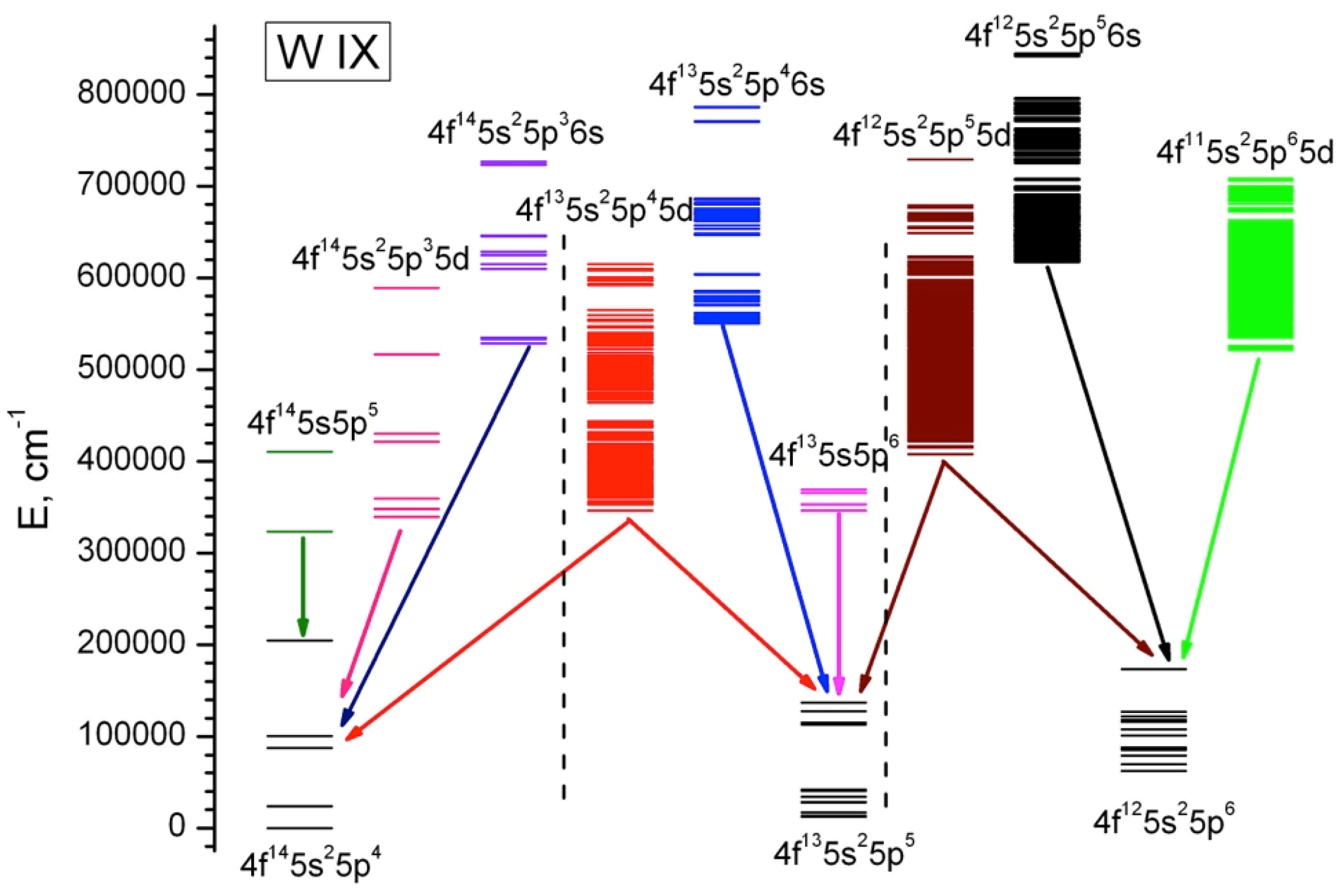
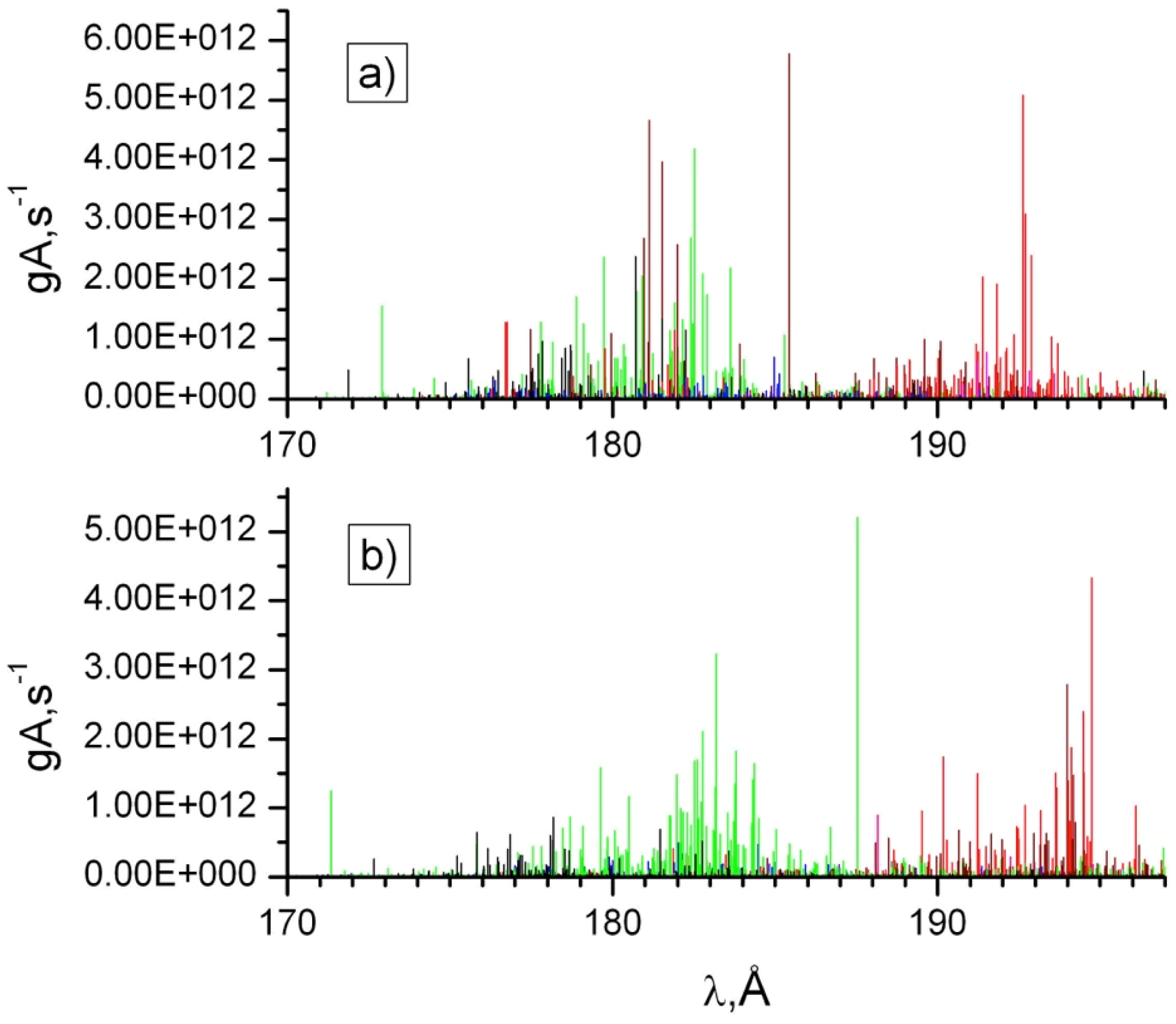
| Int a | λ (Å) | σ(cm−1) |
|---|---|---|
| 63 | 170.006 | 588215.3 |
| 84 | 170.203 | 587535.1 |
| 120 | 170.269 | 587306.0 |
| 339 | 170.336 | 587076.3 |
| 95 | 170.353 | 587017.1 |
| 120 | 170.648 | 586001.9 |
| 95 | 171.216 | 584056.2 |
| 309 | 172.038 | 581265.3 |
| 79 | 174.997 | 571437.4 |
| 56 | 175.490 | 569834.3 |
| 59 | 176.002 | 568174.1 |
| 81 | 176.493 | 566595.7 |
| 63 | 176.660 | 566060.4 |
| 82 | 176.752 | 565763.8 |
| 69 | 177.197 | 564342.1 |
| 102 | 177.468 | 563483.1 |
| 178 | 177.504 | 563367.9 |
| 66 | 177.591 | 563092.9 |
| 54 | 178.005 | 561782.3 |
| 97 | 178.115 | 561435.0 |
| 95 | 178.140 | 561355.3 |
| 67 | 178.220 | 561104.9 |
| 76 | 178.473 | 560308.2 |
| 104 | 178.490 | 560256.4 |
| 64 | 178.508 | 560199.6 |
| 86 | 178.956 | 558797.5 |
| 59 | 179.023 | 558588.7 |
| 110 | 179.631 | 556696.2 |
| 56 | 180.080 | 555310.0 |
| 69 | 180.164 | 555049.6 |
| 94 | 180.570 | 553802.8 |
| 109 | 180.922 | 552725.6 |
| 71 | 180.955 | 552624.8 |
| 128 | 180.986 | 552529.6 |
| 61 | 181.247 | 551733.3 |
| 51 | 181.428 | 551184.1 |
| 115 | 181.818 | 550000.3 |
| 100 | 181.835 | 549949.1 |
| 69 | 181.958 | 549578.9 |
| 74 | 182.184 | 548896.8 |
| 72 | 182.437 | 548135.0 |
| 143 | 182.505 | 547928.7 |
| 76 | 182.614 | 547604.1 |
| 77 | 182.824 | 546973.6 |
| 54 | 182.932 | 546652.4 |
| 166 | 182.990 | 546478.9 |
| 156 | 183.081 | 546205.8 |
| 107 | 183.093 | 546169.9 |
| 110 | 183.271 | 545640.7 |
| 53 | 183.305 | 545537.9 |
| 54 | 183.573 | 544743.0 |
| 51 | 183.771 | 544154.0 |
| 110 | 184.033 | 543380.8 |
| 63 | 184.070 | 543271.6 |
| 64 | 184.156 | 543018.2 |
| 248 | 184.200 | 542887.0 |
| 117 | 184.271 | 542680.2 |
| 58 | 184.438 | 542188.2 |
| 86 | 184.538 | 541893.8 |
| 95 | 184.545 | 541872.9 |
| 56 | 184.818 | 541072.3 |
| 59 | 185.727 | 538424.7 |
| 67 | 186.218 | 537004.4 |
| 54 | 186.297 | 536778.4 |
| 252 | 186.428 | 536399.6 |
| 51 | 186.456 | 536318.4 |
| 74 | 186.479 | 536253.7 |
| 79 | 186.506 | 536175.2 |
| 71 | 186.539 | 536080.1 |
| 166 | 186.680 | 535676.3 |
| 51 | 187.890 | 532225.4 |
| 92 | 188.104 | 531621.1 |
| 77 | 188.114 | 531591.4 |
| 104 | 188.197 | 531357.6 |
| 105 | 188.706 | 529925.1 |
| 82 | 189.264 | 528363.3 |
| 161 | 190.062 | 526143.6 |
| 66 | 190.391 | 525234.9 |
| 56 | 190.596 | 524670.6 |
| 107 | 191.103 | 523278.3 |
| 82 | 191.464 | 522291.7 |
| 304 | 191.933 | 521016.0 |
| 243 | 191.984 | 520876.5 |
| 54 | 192.090 | 520589.6 |
| 84 | 192.117 | 520516.2 |
| 87 | 192.468 | 519567.4 |
| 370 | 192.591 | 519234.0 |
| 199 | 192.715 | 518901.5 |
| 102 | 192.771 | 518749.7 |
| 541 | 192.834 | 518581.8 |
| 194 | 192.859 | 518514.3 |
| 132 | 193.091 | 517889.5 |
| 87 | 193.174 | 517667.5 |
| 115 | 193.229 | 517519.6 |
| 53 | 193.342 | 517218.7 |
| 118 | 193.411 | 517032.3 |
| 95 | 193.428 | 516987.7 |
| 290 | 193.490 | 516822.8 |
| 443 | 193.549 | 516664.0 |
| 303 | 193.636 | 516432.4 |
| 209 | 193.719 | 516210.8 |
| 181 | 193.771 | 516073.6 |
| 696 | 193.830 | 515915.8 |
| 362 | 193.999 | 515467.9 |
| 408 | 194.105 | 515184.6 |
| 148 | 194.140 | 515091.1 |
| 245 | 194.173 | 515006.0 |
| 229 | 194.201 | 514930.2 |
| 58 | 194.268 | 514752.3 |
| 500 | 194.355 | 514522.1 |
| 94 | 194.553 | 513998.2 |
| 1000 | 194.646 | 513752.1 |
| 66 | 194.792 | 513368.4 |
| 99 | 194.803 | 513339.9 |
| 77 | 194.832 | 513262.7 |
| 84 | 194.910 | 513057.8 |
| 66 | 195.114 | 512520.6 |
| 130 | 195.192 | 512315.8 |
| 153 | 195.259 | 512141.3 |
| 255 | 195.432 | 511685.6 |
| 102 | 195.469 | 511590.1 |
| 51 | 195.483 | 511552.7 |
| 439 | 195.679 | 511040.5 |
| 66 | 195.745 | 510869.3 |
| 67 | 195.794 | 510741.2 |
| 77 | 195.921 | 510410.6 |
| 140 | 196.129 | 509869.5 |
| 51 | 196.242 | 509573.9 |
| 53 | 196.371 | 509239.9 |
| 99 | 196.577 | 508707.6 |
| 192 | 196.592 | 508667.4 |
| 61 | 196.665 | 508478.4 |
| 66 | 196.732 | 508306.8 |
| 51 | 196.947 | 507751.1 |
| 357 | 196.966 | 507702.1 |
| 77 | 197.013 | 507579.9 |
| 120 | 197.057 | 507467.9 |
| 138 | 197.136 | 507263.3 |
| 169 | 197.350 | 506714.7 |
| 311 | 197.607 | 506056.2 |
| 72 | 197.736 | 505724.8 |
| 110 | 197.810 | 505535.9 |
| 66 | 198.008 | 505031.4 |
| 53 | 198.095 | 504807.3 |
| 114 | 198.196 | 504551.3 |
| 53 | 198.378 | 504088.7 |
| 71 | 198.391 | 504056.4 |
| 64 | 198.464 | 503869.7 |
| 128 | 198.543 | 503668.5 |
| 161 | 198.562 | 503621.8 |
4. Conclusions
Supplementary Materials
Acknowledgments
Author Contributions
Conflicts of Interest
References
- Skinner, C.H. Atomic physics in the quest for fusion energy and ITER. Phys. Scr. 2009, 134, 014022. [Google Scholar] [CrossRef]
- Kramida, A.E.; Shirai, T. Energy levels and spectral lines of tungsten, W III through W LXXIV. At. Data Nucl. Data Tables 2009, 95, 305–474. [Google Scholar] [CrossRef]
- Kramida, A.E. Recent progress in spectroscopy of tungsten. Can. J. Phys. 2011, 89, 551–570. [Google Scholar] [CrossRef]
- Veres, G.; Bakos, J.S.; Kardon, B. Energy levels and vacuum ultraviolet spectrum of W VIII. J. Quant. Spectrosc. Ra. 1996, 56, 295–301. [Google Scholar] [CrossRef]
- Sugar, J.; Kaufman, V. Seventh spectrum of tungsten (W VII); resonance lines of Hf V. Phys. Rev. A 1975, 12, 994–1012. [Google Scholar] [CrossRef]
- Clementson, J.; Beiersdorfer, P.; Magee, E.W.; McLean, H.S.; Wood, R.D. Tungsten spectroscopy relevant to the diagnostics of ITER divertor plasmas. J. Phys. B 2010, 43, 144009. [Google Scholar] [CrossRef]
- Suzuki, C.; Harte, C.S.; Kilbane, D.; Kato, T.; Sakaue, H.A.; Murakami, I.; Kato, D.; Sato, K.; Tamura, N.; Sudo, S.; et al. Interpretation of spectral emission in the 20 nm region from tungsten ions observed in fusion device plasmas. J. Phys. B 2011, 44, 175004. [Google Scholar] [CrossRef]
- International Atomic Energy Agency. Atomic Molecular Data Services. Available online: http://www-amdis.iaea.org/CRP/Tungsten/ (accessed on 1 April 2015).
- Ryabtsev, A.N.; Kononov, E.Y.; Kildiyarova, R.R.; Tchang-Brillet, W.-Ü.L.; Wyart, J.-F. 4f135s25p6–4f135s25p56s Transitions in the W VIII spectrum and spectra of isoelectronic Hafnium, Tantalum, and Rhenium ions. Opt. Spectrosc. 2012, 113, 109–114. [Google Scholar] [CrossRef]
- Ryabtsev, A.N.; Kononov, E.Y.; Kildiyarova, R.R.; Tchang-Brillet, W.-Ü.L.; Wyart, J.-F. The spectrum of seven times ionized tungsten (W VIII) relevant to tokamak divertor plasmas. Phys. Scr. 2013, 87, 045303. [Google Scholar] [CrossRef]
- Ryabtsev, A.N.; Kononov, E.Y.; Kildiyarova, R.R.; Tchang-Brillet, W.-Ü.L.; Wyart, J.-F.; Champion, N.; Blaess, C. Spectra of the W VIII isoelectronic sequence: I. Hf VI. Phys. Scr. 2014, 89, 115402. [Google Scholar] [CrossRef]
- Ryabtsev, A.N.; Kononov, E.Y.; Kildiyarova, R.R.; Tchang-Brillet, W.-Ü.L.; Wyart, J.-F.; Champion, N.; Blaess, C. Spectra of the W VIII isoelectronic sequence: II.Ta VII. Phys. Scr. 2014, 89, 125403. [Google Scholar] [CrossRef]
- Ryabtsev, A.N.; Kononov, E.Y.; Kildiyarova, R.R.; Tchang-Brillet, W.-Ü.L.; Wyart, J.-F.; Champion, N.; Blaess, C. Spectra of the W VIII isoelectronic sequence: III. Re IX. Phys. Scr. 2015. submitted. [Google Scholar]
- Svensson, L.A.; Ekberg, J.O. The titanium vacuum-spark spectrum from 50 to 425 Å. Ark. Fys. 1969, 40, 145–164. [Google Scholar]
- Engström, L. Lund Reports on Atomic Physics, LRAP-232. (Lund, 1998). Available online: http://kurslab-atom.fysik.lth.se/Lars/Gfit/html/index.html (accessed on 17 June 2015).
- Meftah, A.; Wyart, J.-F.; Sinzelle, J.; Tchang-Brillet, W.-Ü.L.; Champion, N.; Spector, N.; Sugar, J. Spectrum and energy levels of the Nd4+ free ion (Nd V). Phys. Scr. 2008, 77, 055302. [Google Scholar] [CrossRef]
- Azarov, V.I. Formal approach to the solution of the complex-spectra identification problem. 2. Implementaton. Phys. Scr. 1993, 48, 656–667. [Google Scholar] [CrossRef]
- Cowan, R.D. The Theory of Atomic Structure and Spectra; University of California Press: Berkeley, CA, USA, 1981. [Google Scholar]
- Kramida, A.E. The program LOPT for least-squares optimization of energy levels. Comput. Phys. Commun. 2010, 182, 419–434. [Google Scholar] [CrossRef]
- Kaufman, V.; Sugar, J. Analysis of the spectrum of four-times-ionized lutetium (Lu V). J. Opt. Soc. Am. 1978, 68, 1529–1541. [Google Scholar] [CrossRef]
- Kaufman, V.; Sugar, J.; National Institute of Standards and Technology, MD, USA. Unpublished line list. 1980.
- Wyart, J.-F.; Kaufman, V.; Sugar, J. The 4f135f Configuration in the Isoelectronic Sequence of Yb III. Phys. Scr. 1981, 23, 1069–1078. [Google Scholar] [CrossRef]
- Wyart, J.-F.; Tchang-Brillet, W.-Ü.L.; Spector, N.; Palmeri, P.; Quinet, P.; Biemont, E. Extended analysis of the spectrum of triply-ionized ytterbium (Yb IV) and transition probabilities. Phys. Scr. 2001, 63, 113–121. [Google Scholar] [CrossRef]
- Meftah, A.; Wyart, J.-F.; Champion, N.; Tchang-Brillet, W.-Ü.L. Observation and interpretation of the Tm3+ free ion spectrum. Eur. Phys. J. D 2007, 44, 35–45. [Google Scholar] [CrossRef]
- Meftah, A.; Wyart, J.-F.; Tchang-Brillet, W.-Ü.L.; Blaess, C.; Champion, N. Spectrum and energy levels of the Yb4+ free ion (Yb V). Phys. Scr. 2013, 88, 045305. [Google Scholar] [CrossRef]
© 2015 by the authors; licensee MDPI, Basel, Switzerland. This article is an open access article distributed under the terms and conditions of the Creative Commons Attribution license (http://creativecommons.org/licenses/by/4.0/).
Share and Cite
Ryabtsev, A.; Kononov, E.; Kildiyarova, R.; Tchang-Brillet, W.-Ü.L.; Wyart, J.-F.; Champion, N.; Blaess, C. Spectra of W VIII and W IX in the EUV Region. Atoms 2015, 3, 273-298. https://doi.org/10.3390/atoms3030273
Ryabtsev A, Kononov E, Kildiyarova R, Tchang-Brillet W-ÜL, Wyart J-F, Champion N, Blaess C. Spectra of W VIII and W IX in the EUV Region. Atoms. 2015; 3(3):273-298. https://doi.org/10.3390/atoms3030273
Chicago/Turabian StyleRyabtsev, Alexander, Edward Kononov, Rimma Kildiyarova, Wan-Ü Lydia Tchang-Brillet, Jean-Francois Wyart, Norbert Champion, and Christophe Blaess. 2015. "Spectra of W VIII and W IX in the EUV Region" Atoms 3, no. 3: 273-298. https://doi.org/10.3390/atoms3030273





